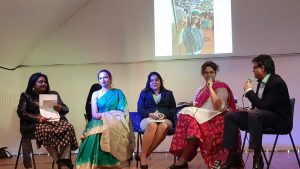In 1999, following an initiative by Bangladesh, UNESCO declared that 21 February would be International Mother Language Day, and it’s been observed every year since the turn of the millennium. The date has significance because it was in 1952 that thousands amassed in Bangladesh’s capital, Dhaka, to protest against the suppression of their native language.
Preserving culture
The goal for this day is for UNESCO to drive the importance of cultural and linguistic diversity as a key part of sustainable societies. It is within UNESCO’s mandate for peace that it works to preserve the differences in cultures and languages that foster tolerance and respect for others.
In East London almost two years ago, 2 March to be precise, an event was held to celebrate this day. There was a mix of performances: music, poetry, a short play, and there was also a debate. The panel was composed entirely of women, who brought a wide range of points to the conversation. The motion for the debate was “does language and culture flourish with immigrant population?”
Our Founder Smita Sarkar was one of the invited speakers at the debate organised by Dr Arpita Ray of Essex Indians in London. Smita was tasked with opposing the motion and warned of the dangers that immigration can lead to a diluting of a native language as immigrants adapt to their new home country. This only goes to emphasise how important it is for cultures to make extra efforts to preserve their mother language.
Opposing the motion with her was Dr Sanjukta Ghosh of SOAS University and speaking for the motion was Rashmu Mishra, Founder of Inspiring Indian Women and Geeta Sharma, Hindi instructor at the Met Police, London.

The debate speech
Language and Culture Flourishes with immigration. I agree that it can – but it depends on the circumstances and the type of immigration, the immigrants themselves and the host country. Anti-immigration is often associated with right-wing bigotry and fascism, but I believe that beyond those reactionary and hateful viewpoints; there are valid reasons as to why immigration can be detrimental to language and culture – both for the host countries and indeed the immigrants themselves.
Let’s start with culture. Much is made about the positive side of immigration. Often the most apparent cultural changes that reach the greatest amount of the population comes from the introduction of new cuisine, music or fashion.
Selective immigration can make sure that you gain people who bring in relevant skills and can increase productivity for the host country. However, vetting procedures at times may not be able to keep out certain undesirable cultural traits, such as gender inequality, class discrimination or religious intolerance.
Immigrants can bring with them their bad cultures, ideas, or factors that can undermine and damage both economic and political institutions of the host country. The resultant weakening in economic growth only means that immigrants end up destroying more wealth than they create.
However, money can be the least of the negative influences that immigration can allow into a country. For example, misogyny and the mistreatment of women can often be found to follow immigrant populations. Immigration usually happens from less-developed countries where their attitudes can be behind the times of their more-developed counterparts.
And while abusive behaviour to women can happen with legal immigration, the situation becomes even harder to quantify when illegal immigration is included. Illegal immigrants often work for less than minimum wage, thereby lowering the disposable income for the host population as wages fall. This can then curtailing certain aspects of the host culture which they can no longer afford in the home country.
This is probably why certain host countries feel that they need to add filters to their immigration requirements. For example, Poland allows middle east immigrants who are Christians only. They probably feel that if you bring in too many people, you run the risk of destroying your own culture.
Coming to languages and how that flourishes with immigration… there was a time when several dialects flourished in small pockets across the world when everybody lived in separate communities and each created their own language. But with immigration, that phenomenon seem to be changing. The immigrants have to learn the language of their host countries.
I feel the immigrants don’t do too well out of this itself. Children raised in host countries do not pick up their own culture and language as much as they would. It becomes harder for them to keep learning their mother-tongue, with fewer opportunities to use it. A language that is under-used may slowly be forgotten by subsequent generations.
The immigrant’s children, growing up amid native speakers of their host countries will likely be able to speak the language with more perfection, but they might also pick up a dialect that would have a strong influence of the language of their country of origin.
If we take the examples of Germany, that expects over 1.5 million applications from Syrian refugees in the next few months, but have been accepting Turkish and Arabic speaking immigrants for decades now; this mesh of languages has resulted in a dialect called Kiezdeutsch, a German that has been gelled with Arabic and Turkish.
Similar versions of dialects have emerged in Denmark, Norway, Holland, Sweden and Italy (countries with high immigrant population). Linguists have termed the new versions of these primary languages as ‘multi-ethnolects’
In simpler words people use the vocabulary of the host countries and applied that to their grammar.
Each time a new immigrant population enters a country, a new language is born.
We see something quite similar with the America’s Black English, spoken in-group among the younger generation of Black Americans. This is a colloquial English that retained the grammatical features of the broken English that was spoken by the previous generations.
In the south-eastern region of the Democratic Republic of Congo, children of migrant workers created a “streamlined” version of Swahili way back in the 20th century. Today, this “Shaba Swahili” is used as a native language by millions.
There are several more examples of multi-ethnolects emerging out of immigrations in countries like Senegal, Indonesia, and Haiti.
What can then happen is that immigrants end up in a host country speaking a dialect that neither their host country or their original homeland would completely understand. This can lead to that group being cut-off from the main population and becoming a ghetto. These areas typically end up becoming a problem for the host country as more immigrants come over and join this self-segregated community.
In conclusion, I hope I have shown you that immigration can be far from flourishing, rather it can actually be a danger to the culture and language of immigrant communities. Cultures can be diluted and lost, bad cultures can affect the host countries, while languages can be fragmented, create ghettos, and prevent their successful integration.



![Powerful Pride documentary Legendary Children [All Of Them Queer] streaming very soon](https://globalindianstories.org/wp-content/uploads/2025/06/Legendary-streaming-release-featured-238x178.jpg)



![Powerful Pride documentary Legendary Children [All Of Them Queer] streaming very soon](https://globalindianstories.org/wp-content/uploads/2025/06/Legendary-streaming-release-featured-100x75.jpg)

